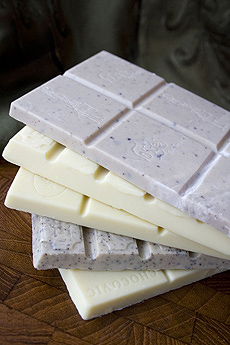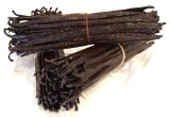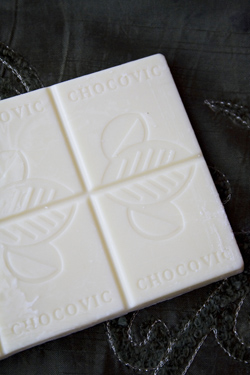 White chocolate. The darker bars have inclusions: olives in the tip bar and ground coffee beans in the fourth bar. Photo by Claire Freiermann | THE NIBBLE from our review of The World’s Best White Chocolate, a NIBBLE Top Pick Of The Week. White chocolate. The darker bars have inclusions: olives in the tip bar and ground coffee beans in the fourth bar. Photo by Claire Freiermann | THE NIBBLE from our review of The World’s Best White Chocolate, a NIBBLE Top Pick Of The Week.
Last Updated May 2018 |
Product Reviews / Main Nibbles / ChocolateChocolate GlossaryChocolate Terms & Definitions: U To Z
Here you’ll find terms including vanilla, varietal and white chocolate. If you think we should consider chocolate terms and definitions other than those we have provided, click on the Contact Us link on this page. Also enjoy our 60+ other food glossaries. Use this index bar to visit other pages. a b c d e f g h i j k l m n o p q r s t u v w x y z This glossary is protected by copyright and cannot be reproduced in whole or part.
UNSWEETENED CHOCOLATESolid chocolate made from 100% chocolate liquor, with no sugar or emulsifiers added. Top quality 100% cacao bars are excellent for eating if one likes intense cacao flavor. Note: some people in the trade refer to chocolate liquor as unsweetened chocolate. VANILLAThe flavor extract derived from the vanilla bean, the pod of a tropical orchid. The pods are harvested green and cured, turning brown when heated in ovens. Each pod contains numerous seeds. Vanilla extract is made by chopping or macerating beans, then mixing them with ethyl alcohol and water, aging the solution, and filtering out the solids. Pure vanilla extract must be 35% alcohol by volume. Vanilla is native to southern Mexico, although the majority of today’s supply comes from Madagascar (known as bourbon vanilla); secondarily from Tahiti (the finest and rarest); Mexico is the third largest source. Almost all fine chocolate is enhanced with vanilla. Just as with cacao beans, vanilla from different parts of the world has different flavor complexities, and specific vanillas are paired with specific chocolates to achieve different results. The Madagascar bean (Bourbon bean) is very thin and very rich in sweetness. It has a thick oily skin that covers many small seeds that provide a strong vanilla aroma. The Mexican bean is not as thin and not quite as sweet as the Madagascar bean. The bean has a somewhat earthy aroma and is more mellow in flavor than the bourbon bean. The Tahiti bean is plumper in size, darker in color, and the least sweet of the beans. Its thin-skinned pod covers fewer seeds than the other varieties and they have a slightly fruity aroma. While the orchid family is the second largest family of flowering plants with approximately 20,000 species, the Vanilla genus is the only group that produces anything edible. See our comprehensive article on vanilla.
VANILLA EXTRACTVanilla beans are expensive and time consuming to split open and work with to flavor dishes. To save time and money, an extract is produced by steeping vanilla beans in an alcohol and water solution; the alcohol and water cook out, leaving the essence. Pure vanilla is concentrated and only a small amount is needed for flavoring. However, it is an expensive flavoring to produce, which has led to the proliferation of synthetically produced vanilla—vanillin. This is generally labeled Artificial Vanilla Extract at retail; but the word artificial is often in small letters: look closely to avoid purchasing the wrong product. See our recommendations of the best vanilla extract brands. VANILLINNatural vanillin is a white crystalline compound found in the pulp of vanilla beans and is the largest component in vanilla. The flavoring ethyl vanillin is manufactured commercially, an artificial by-product of the wood pulp used in the paper industry. Ethyl vanillin is substituted for vanilla in lesser chocolate. It can often be identified by a strong vanilla smell: Natural vanilla is much more subtle. VARIETALA biological variety; a chocolate made from one particular subspecies of beans: Criollo, Forastero, or Trinitario. Borrowed from wine terminology, where it refers to a wine made principally from one variety of grape and carrying the name of that grape, e.g. Cabernet Sauvignon, Chardonnay, Pinot Noir. The term is also used to describe coffee beans and other fruits like peppercorns; another term, cultivar, is used for fruits like avocados and olives.
XOCOATL or XOCOLATLPronounced shock-WA-tel, the Mayan word for chocolate. It means bitter water. The original chocolate beverage was an unsweetened drink mixed with maize and flavored with pepper and other savory spices. The word “cacao” originated with the Olmec peoples who occupied the lowland regions of the eastern Mexican gulf coast; originally pronounced kakawa, “cacao” derived from the Mixe-Zoquean family of languages spoken by the Olmec, and was probably in use by 1000 B.C.* The Olmec shared their knowledge of cacao with the adjacent Mayans. The Nahuatl (Aztec language) term cacahuatl for cacao was concocted from the Mayan word. See chocolate for the etymology of the word.
Lifestyle Direct, Inc. All rights reserved. Images are the copyright of their respective owners.
|
Last Updated May 2018
© Copyright 2005-2025 Lifestyle Direct, Inc. All rights reserved. All images are copyrighted to their respective owners.



